Agile Project Management Methodology
VerifiedAdded on 2021/04/21
|16
|2436
|68
AI Summary
The assignment explores the concept of agile project management, its principles, tools, and techniques. It discusses how agile can be applied to non-software projects, setting proper expectations with stakeholders, and promoting creativity within the project. The report also highlights the use of agile workflow strategies and tools in executing projects successfully, minimizing risks, and combating project failure.
Contribute Materials
Your contribution can guide someone’s learning journey. Share your
documents today.

Running head: PROJECT MANAGEMENT CAPSTONE
Project Management Capstone
[Name of the Student]
[Name of the University]
[Author note]
Project Management Capstone
[Name of the Student]
[Name of the University]
[Author note]
Secure Best Marks with AI Grader
Need help grading? Try our AI Grader for instant feedback on your assignments.
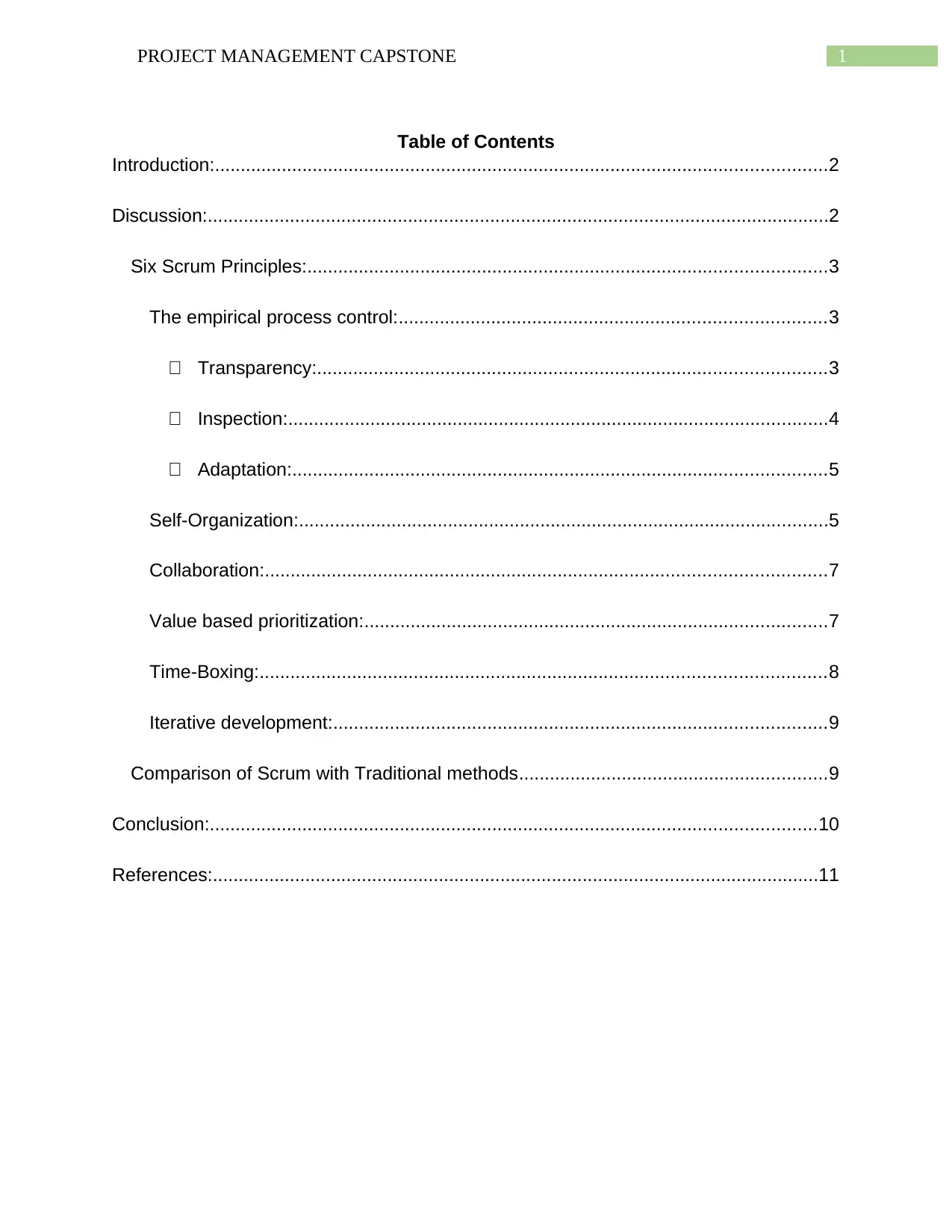
1PROJECT MANAGEMENT CAPSTONE
Table of Contents
Introduction:.......................................................................................................................2
Discussion:.........................................................................................................................2
Six Scrum Principles:.....................................................................................................3
The empirical process control:...................................................................................3
Transparency:...................................................................................................3
Inspection:.........................................................................................................4
Adaptation:........................................................................................................5
Self-Organization:.......................................................................................................5
Collaboration:.............................................................................................................7
Value based prioritization:..........................................................................................7
Time-Boxing:..............................................................................................................8
Iterative development:................................................................................................9
Comparison of Scrum with Traditional methods............................................................9
Conclusion:......................................................................................................................10
References:......................................................................................................................11
Table of Contents
Introduction:.......................................................................................................................2
Discussion:.........................................................................................................................2
Six Scrum Principles:.....................................................................................................3
The empirical process control:...................................................................................3
Transparency:...................................................................................................3
Inspection:.........................................................................................................4
Adaptation:........................................................................................................5
Self-Organization:.......................................................................................................5
Collaboration:.............................................................................................................7
Value based prioritization:..........................................................................................7
Time-Boxing:..............................................................................................................8
Iterative development:................................................................................................9
Comparison of Scrum with Traditional methods............................................................9
Conclusion:......................................................................................................................10
References:......................................................................................................................11
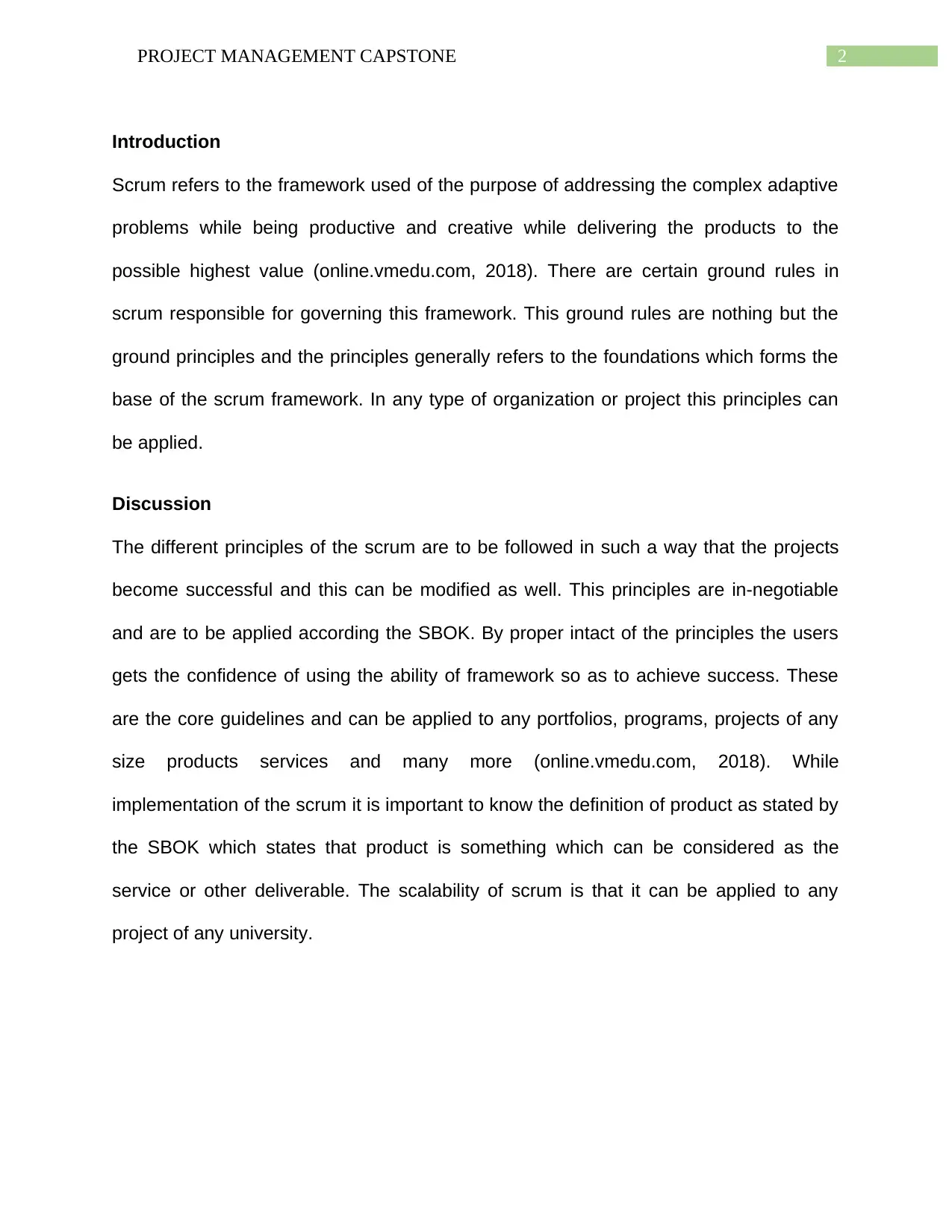
2PROJECT MANAGEMENT CAPSTONE
Introduction
Scrum refers to the framework used of the purpose of addressing the complex adaptive
problems while being productive and creative while delivering the products to the
possible highest value (online.vmedu.com, 2018). There are certain ground rules in
scrum responsible for governing this framework. This ground rules are nothing but the
ground principles and the principles generally refers to the foundations which forms the
base of the scrum framework. In any type of organization or project this principles can
be applied.
Discussion
The different principles of the scrum are to be followed in such a way that the projects
become successful and this can be modified as well. This principles are in-negotiable
and are to be applied according the SBOK. By proper intact of the principles the users
gets the confidence of using the ability of framework so as to achieve success. These
are the core guidelines and can be applied to any portfolios, programs, projects of any
size products services and many more (online.vmedu.com, 2018). While
implementation of the scrum it is important to know the definition of product as stated by
the SBOK which states that product is something which can be considered as the
service or other deliverable. The scalability of scrum is that it can be applied to any
project of any university.
Introduction
Scrum refers to the framework used of the purpose of addressing the complex adaptive
problems while being productive and creative while delivering the products to the
possible highest value (online.vmedu.com, 2018). There are certain ground rules in
scrum responsible for governing this framework. This ground rules are nothing but the
ground principles and the principles generally refers to the foundations which forms the
base of the scrum framework. In any type of organization or project this principles can
be applied.
Discussion
The different principles of the scrum are to be followed in such a way that the projects
become successful and this can be modified as well. This principles are in-negotiable
and are to be applied according the SBOK. By proper intact of the principles the users
gets the confidence of using the ability of framework so as to achieve success. These
are the core guidelines and can be applied to any portfolios, programs, projects of any
size products services and many more (online.vmedu.com, 2018). While
implementation of the scrum it is important to know the definition of product as stated by
the SBOK which states that product is something which can be considered as the
service or other deliverable. The scalability of scrum is that it can be applied to any
project of any university.
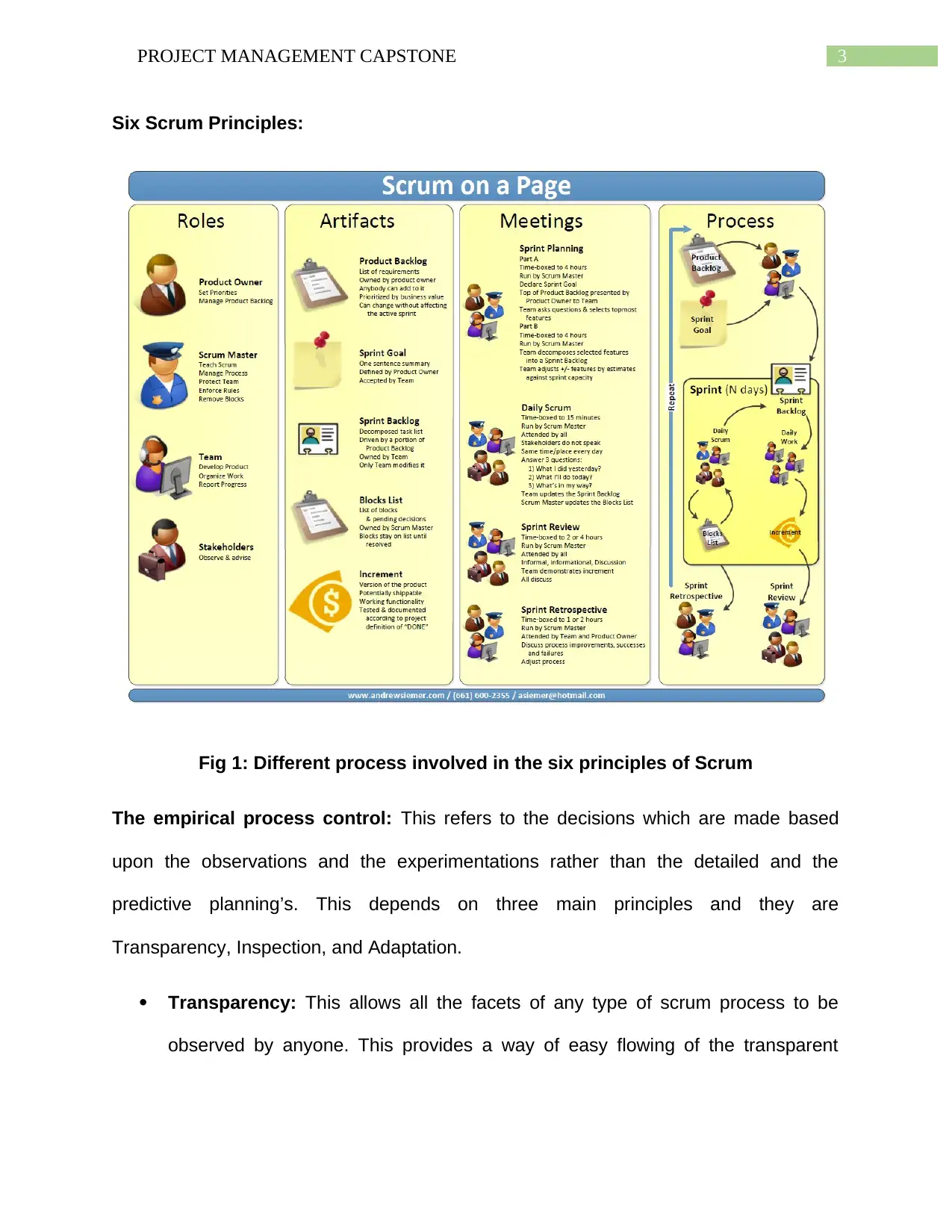
3PROJECT MANAGEMENT CAPSTONE
Six Scrum Principles:
Fig 1: Different process involved in the six principles of Scrum
The empirical process control: This refers to the decisions which are made based
upon the observations and the experimentations rather than the detailed and the
predictive planning’s. This depends on three main principles and they are
Transparency, Inspection, and Adaptation.
Transparency: This allows all the facets of any type of scrum process to be
observed by anyone. This provides a way of easy flowing of the transparent
Six Scrum Principles:
Fig 1: Different process involved in the six principles of Scrum
The empirical process control: This refers to the decisions which are made based
upon the observations and the experimentations rather than the detailed and the
predictive planning’s. This depends on three main principles and they are
Transparency, Inspection, and Adaptation.
Transparency: This allows all the facets of any type of scrum process to be
observed by anyone. This provides a way of easy flowing of the transparent
Secure Best Marks with AI Grader
Need help grading? Try our AI Grader for instant feedback on your assignments.
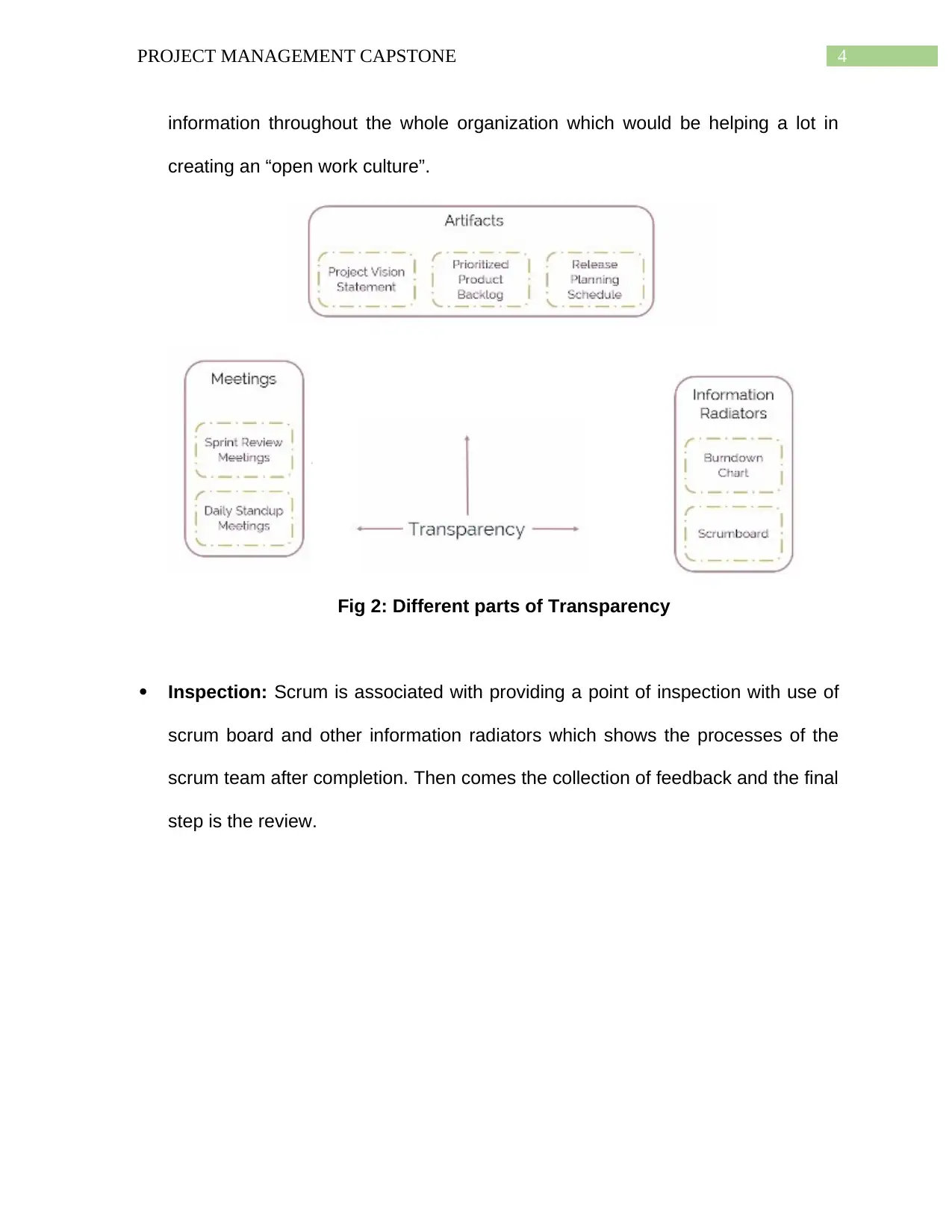
4PROJECT MANAGEMENT CAPSTONE
information throughout the whole organization which would be helping a lot in
creating an “open work culture”.
Fig 2: Different parts of Transparency
Inspection: Scrum is associated with providing a point of inspection with use of
scrum board and other information radiators which shows the processes of the
scrum team after completion. Then comes the collection of feedback and the final
step is the review.
information throughout the whole organization which would be helping a lot in
creating an “open work culture”.
Fig 2: Different parts of Transparency
Inspection: Scrum is associated with providing a point of inspection with use of
scrum board and other information radiators which shows the processes of the
scrum team after completion. Then comes the collection of feedback and the final
step is the review.
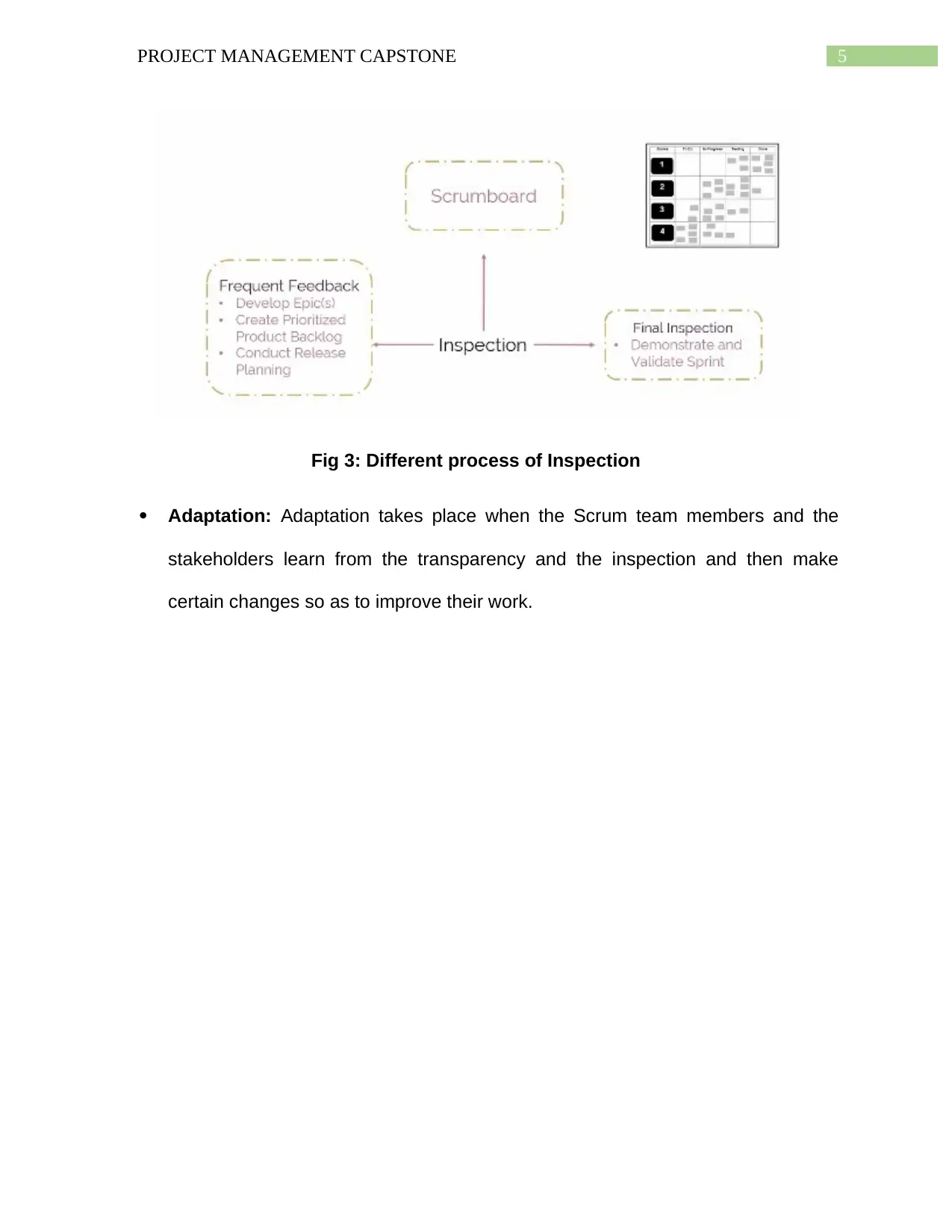
5PROJECT MANAGEMENT CAPSTONE
Fig 3: Different process of Inspection
Adaptation: Adaptation takes place when the Scrum team members and the
stakeholders learn from the transparency and the inspection and then make
certain changes so as to improve their work.
Fig 3: Different process of Inspection
Adaptation: Adaptation takes place when the Scrum team members and the
stakeholders learn from the transparency and the inspection and then make
certain changes so as to improve their work.
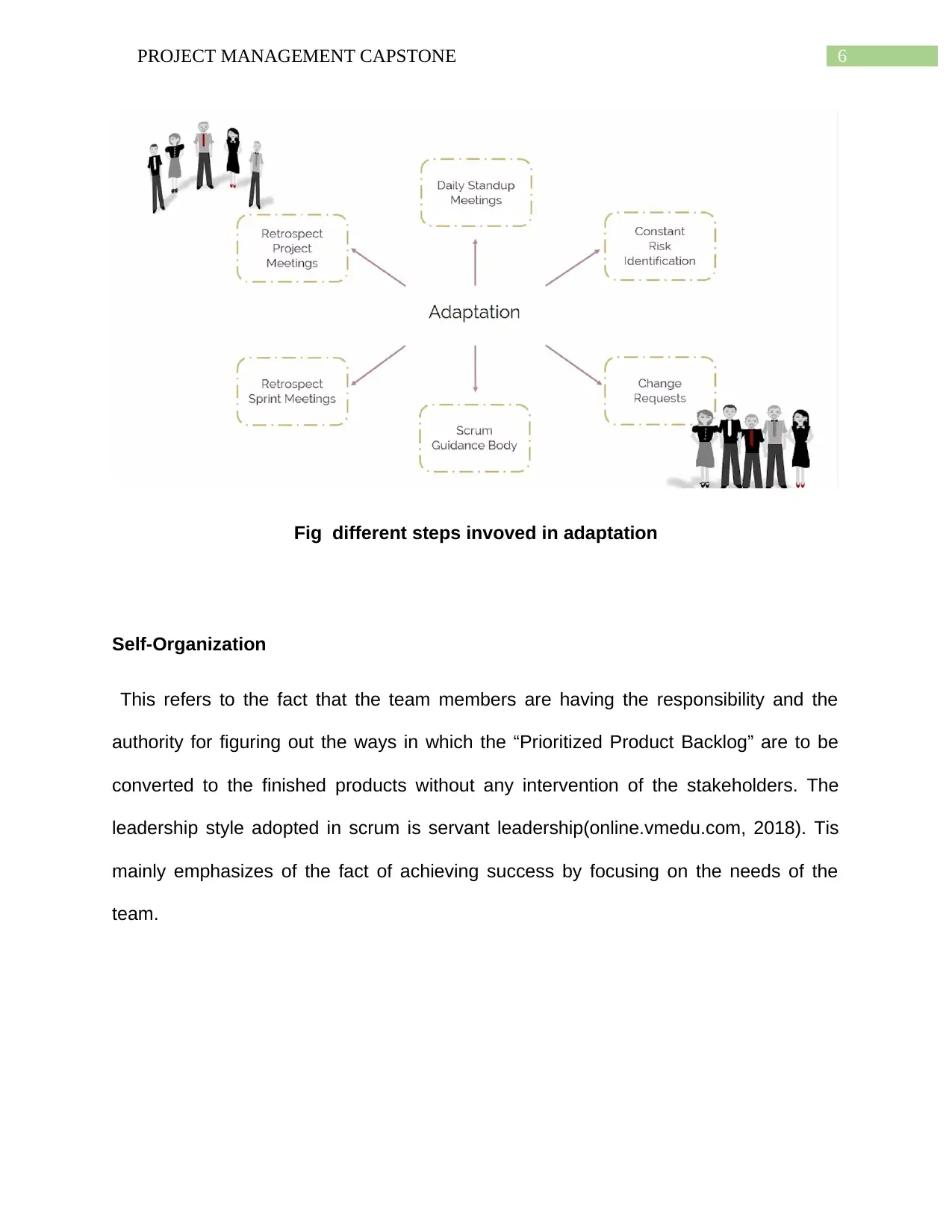
6PROJECT MANAGEMENT CAPSTONE
Fig different steps invoved in adaptation
Self-Organization
This refers to the fact that the team members are having the responsibility and the
authority for figuring out the ways in which the “Prioritized Product Backlog” are to be
converted to the finished products without any intervention of the stakeholders. The
leadership style adopted in scrum is servant leadership(online.vmedu.com, 2018). Tis
mainly emphasizes of the fact of achieving success by focusing on the needs of the
team.
Fig different steps invoved in adaptation
Self-Organization
This refers to the fact that the team members are having the responsibility and the
authority for figuring out the ways in which the “Prioritized Product Backlog” are to be
converted to the finished products without any intervention of the stakeholders. The
leadership style adopted in scrum is servant leadership(online.vmedu.com, 2018). Tis
mainly emphasizes of the fact of achieving success by focusing on the needs of the
team.
Paraphrase This Document
Need a fresh take? Get an instant paraphrase of this document with our AI Paraphraser
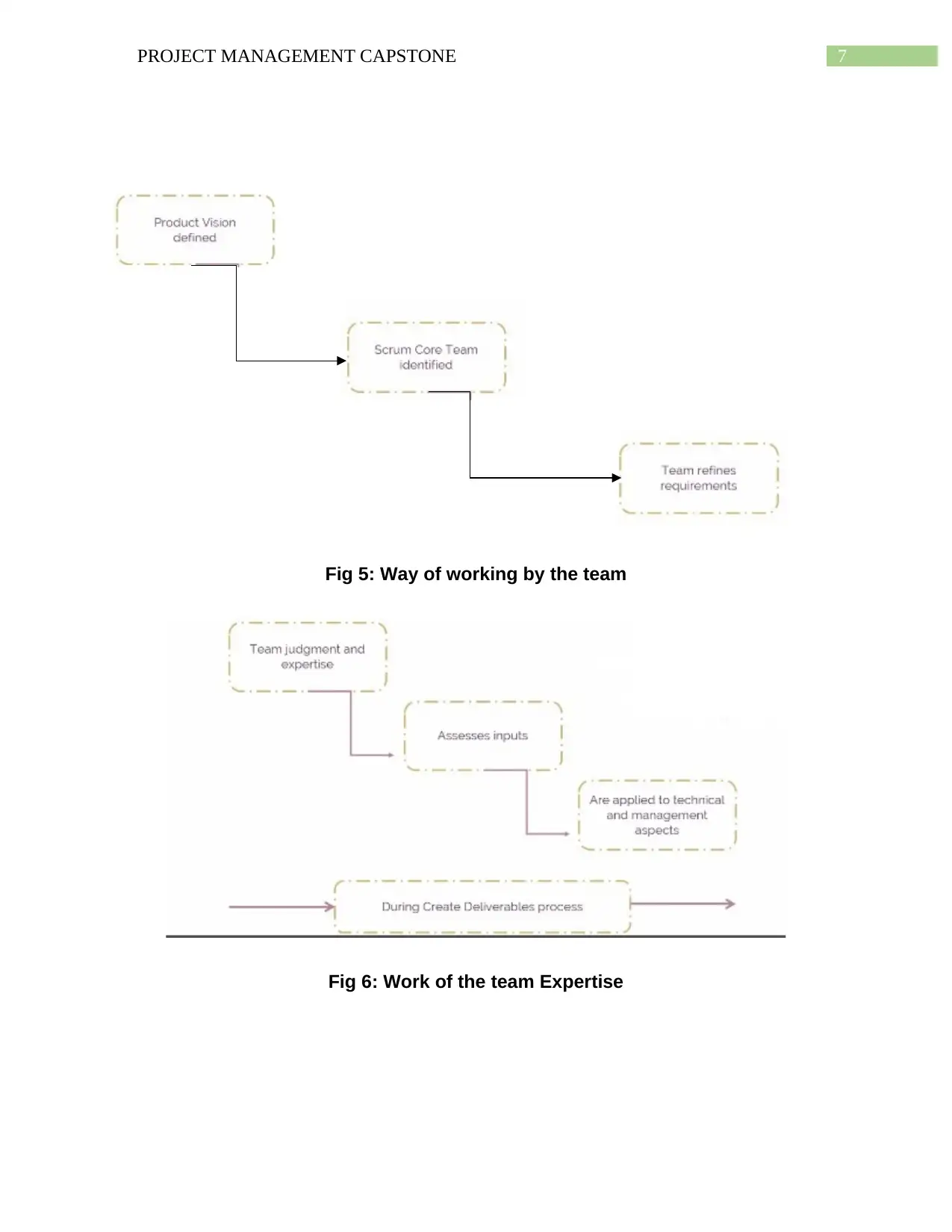
7PROJECT MANAGEMENT CAPSTONE
Fig 5: Way of working by the team
Fig 6: Work of the team Expertise
Fig 5: Way of working by the team
Fig 6: Work of the team Expertise
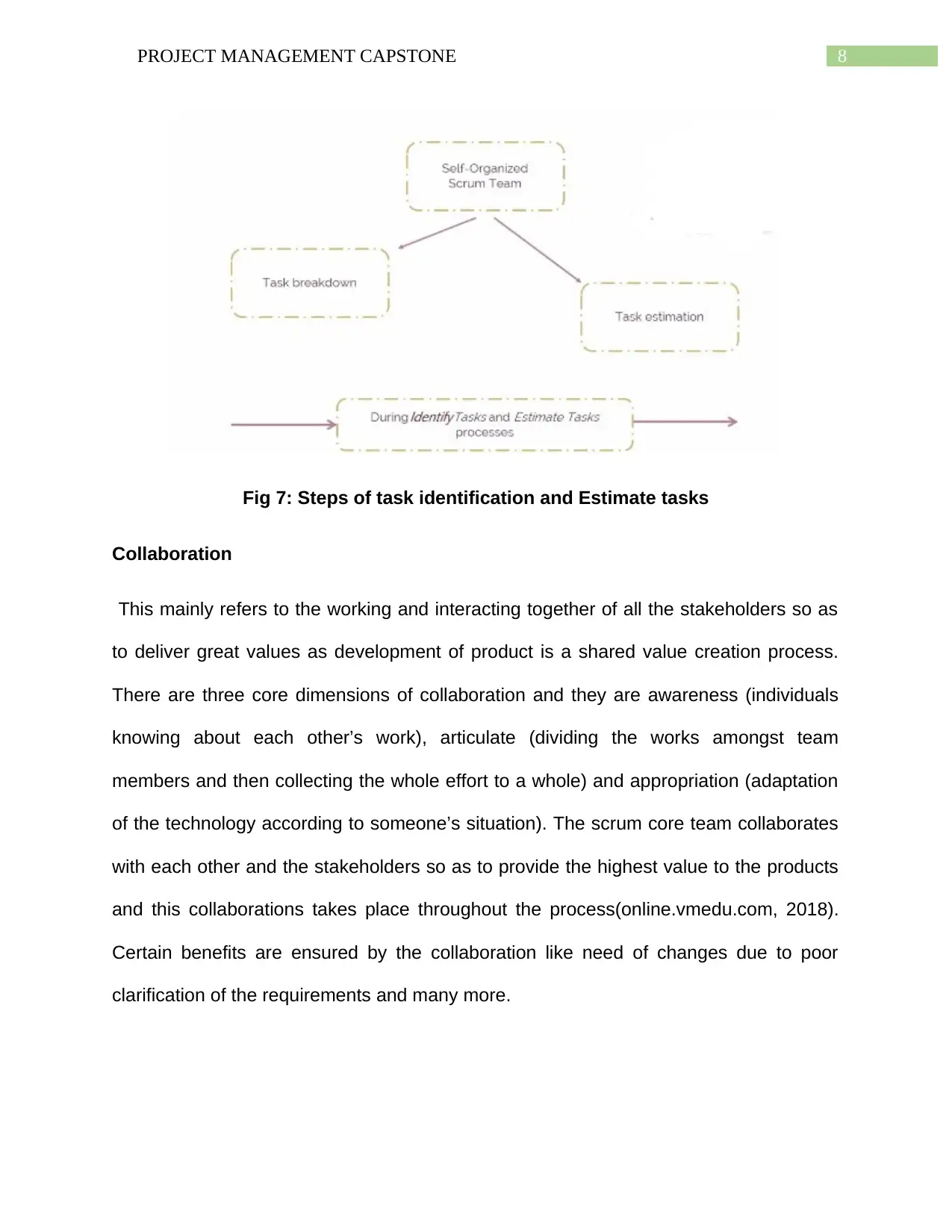
8PROJECT MANAGEMENT CAPSTONE
Fig 7: Steps of task identification and Estimate tasks
Collaboration
This mainly refers to the working and interacting together of all the stakeholders so as
to deliver great values as development of product is a shared value creation process.
There are three core dimensions of collaboration and they are awareness (individuals
knowing about each other’s work), articulate (dividing the works amongst team
members and then collecting the whole effort to a whole) and appropriation (adaptation
of the technology according to someone’s situation). The scrum core team collaborates
with each other and the stakeholders so as to provide the highest value to the products
and this collaborations takes place throughout the process(online.vmedu.com, 2018).
Certain benefits are ensured by the collaboration like need of changes due to poor
clarification of the requirements and many more.
Fig 7: Steps of task identification and Estimate tasks
Collaboration
This mainly refers to the working and interacting together of all the stakeholders so as
to deliver great values as development of product is a shared value creation process.
There are three core dimensions of collaboration and they are awareness (individuals
knowing about each other’s work), articulate (dividing the works amongst team
members and then collecting the whole effort to a whole) and appropriation (adaptation
of the technology according to someone’s situation). The scrum core team collaborates
with each other and the stakeholders so as to provide the highest value to the products
and this collaborations takes place throughout the process(online.vmedu.com, 2018).
Certain benefits are ensured by the collaboration like need of changes due to poor
clarification of the requirements and many more.
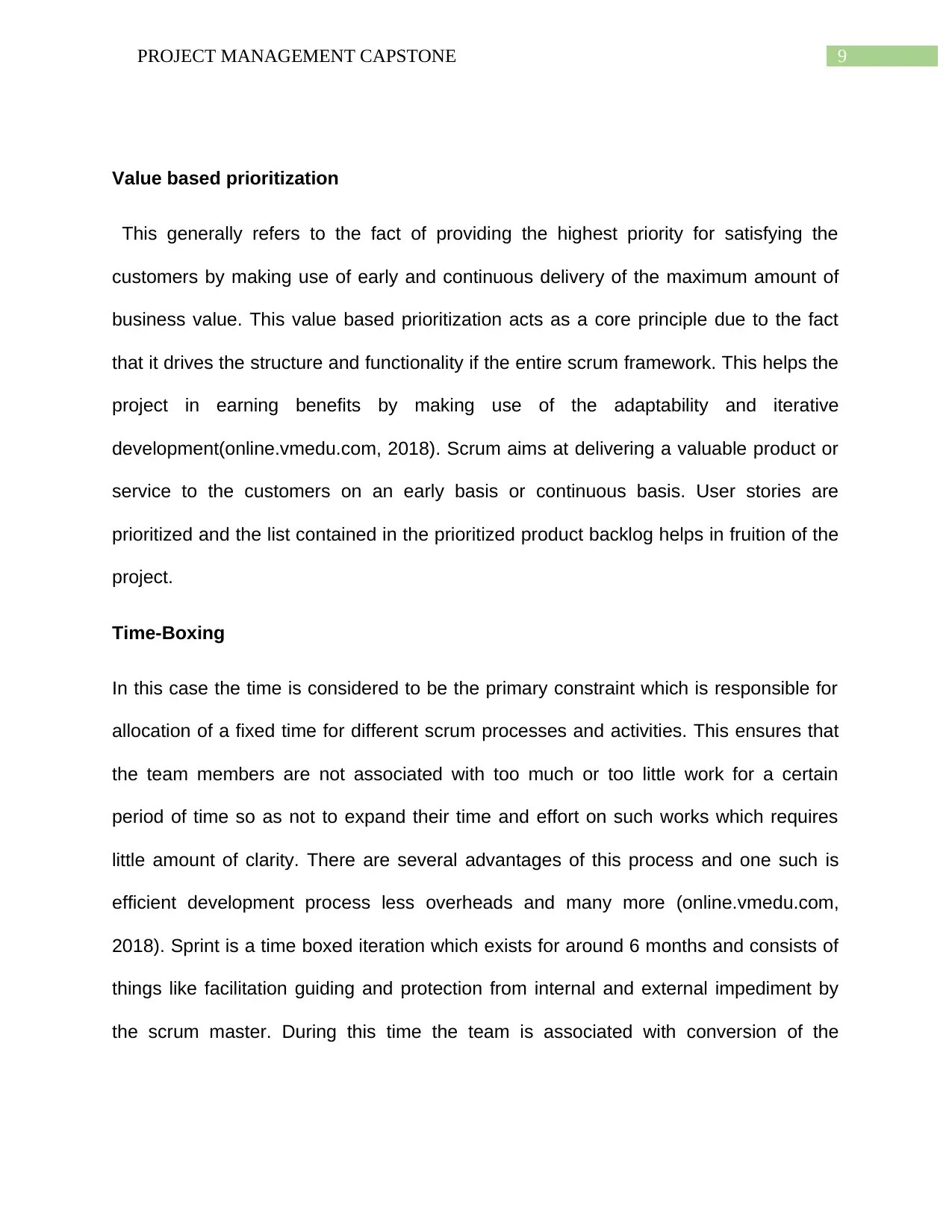
9PROJECT MANAGEMENT CAPSTONE
Value based prioritization
This generally refers to the fact of providing the highest priority for satisfying the
customers by making use of early and continuous delivery of the maximum amount of
business value. This value based prioritization acts as a core principle due to the fact
that it drives the structure and functionality if the entire scrum framework. This helps the
project in earning benefits by making use of the adaptability and iterative
development(online.vmedu.com, 2018). Scrum aims at delivering a valuable product or
service to the customers on an early basis or continuous basis. User stories are
prioritized and the list contained in the prioritized product backlog helps in fruition of the
project.
Time-Boxing
In this case the time is considered to be the primary constraint which is responsible for
allocation of a fixed time for different scrum processes and activities. This ensures that
the team members are not associated with too much or too little work for a certain
period of time so as not to expand their time and effort on such works which requires
little amount of clarity. There are several advantages of this process and one such is
efficient development process less overheads and many more (online.vmedu.com,
2018). Sprint is a time boxed iteration which exists for around 6 months and consists of
things like facilitation guiding and protection from internal and external impediment by
the scrum master. During this time the team is associated with conversion of the
Value based prioritization
This generally refers to the fact of providing the highest priority for satisfying the
customers by making use of early and continuous delivery of the maximum amount of
business value. This value based prioritization acts as a core principle due to the fact
that it drives the structure and functionality if the entire scrum framework. This helps the
project in earning benefits by making use of the adaptability and iterative
development(online.vmedu.com, 2018). Scrum aims at delivering a valuable product or
service to the customers on an early basis or continuous basis. User stories are
prioritized and the list contained in the prioritized product backlog helps in fruition of the
project.
Time-Boxing
In this case the time is considered to be the primary constraint which is responsible for
allocation of a fixed time for different scrum processes and activities. This ensures that
the team members are not associated with too much or too little work for a certain
period of time so as not to expand their time and effort on such works which requires
little amount of clarity. There are several advantages of this process and one such is
efficient development process less overheads and many more (online.vmedu.com,
2018). Sprint is a time boxed iteration which exists for around 6 months and consists of
things like facilitation guiding and protection from internal and external impediment by
the scrum master. During this time the team is associated with conversion of the
Secure Best Marks with AI Grader
Need help grading? Try our AI Grader for instant feedback on your assignments.
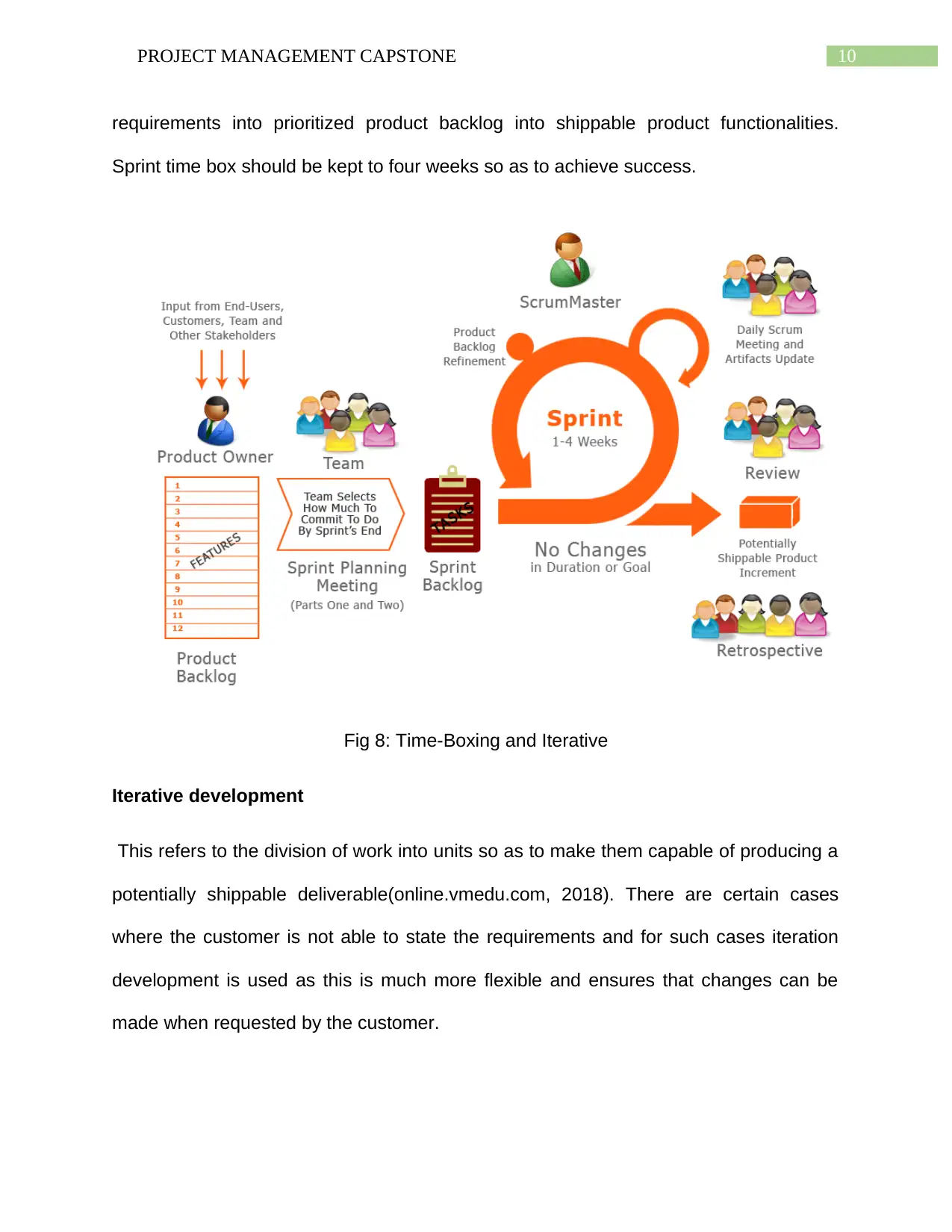
10PROJECT MANAGEMENT CAPSTONE
requirements into prioritized product backlog into shippable product functionalities.
Sprint time box should be kept to four weeks so as to achieve success.
Fig 8: Time-Boxing and Iterative
Iterative development
This refers to the division of work into units so as to make them capable of producing a
potentially shippable deliverable(online.vmedu.com, 2018). There are certain cases
where the customer is not able to state the requirements and for such cases iteration
development is used as this is much more flexible and ensures that changes can be
made when requested by the customer.
requirements into prioritized product backlog into shippable product functionalities.
Sprint time box should be kept to four weeks so as to achieve success.
Fig 8: Time-Boxing and Iterative
Iterative development
This refers to the division of work into units so as to make them capable of producing a
potentially shippable deliverable(online.vmedu.com, 2018). There are certain cases
where the customer is not able to state the requirements and for such cases iteration
development is used as this is much more flexible and ensures that changes can be
made when requested by the customer.
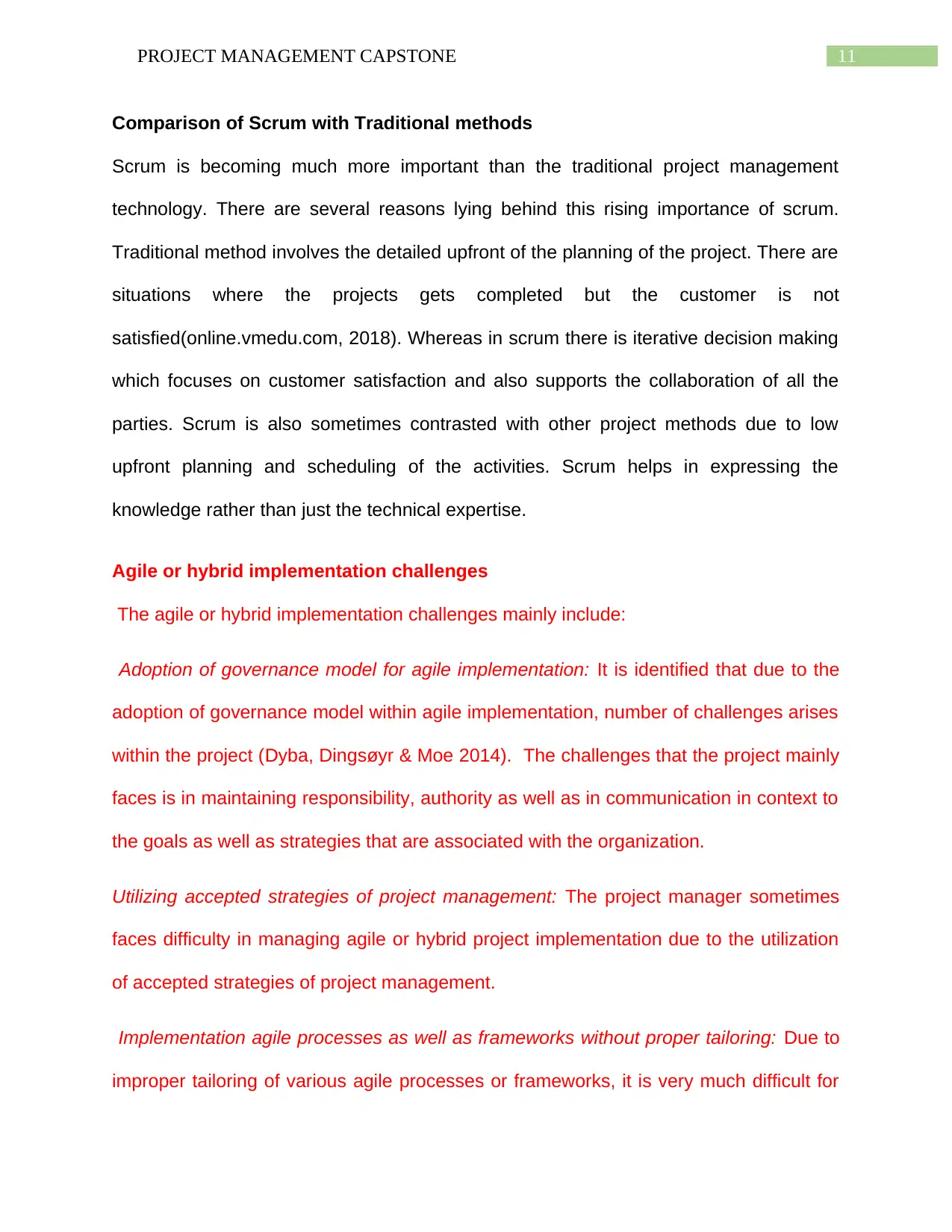
11PROJECT MANAGEMENT CAPSTONE
Comparison of Scrum with Traditional methods
Scrum is becoming much more important than the traditional project management
technology. There are several reasons lying behind this rising importance of scrum.
Traditional method involves the detailed upfront of the planning of the project. There are
situations where the projects gets completed but the customer is not
satisfied(online.vmedu.com, 2018). Whereas in scrum there is iterative decision making
which focuses on customer satisfaction and also supports the collaboration of all the
parties. Scrum is also sometimes contrasted with other project methods due to low
upfront planning and scheduling of the activities. Scrum helps in expressing the
knowledge rather than just the technical expertise.
Agile or hybrid implementation challenges
The agile or hybrid implementation challenges mainly include:
Adoption of governance model for agile implementation: It is identified that due to the
adoption of governance model within agile implementation, number of challenges arises
within the project (Dyba, Dingsøyr & Moe 2014). The challenges that the project mainly
faces is in maintaining responsibility, authority as well as in communication in context to
the goals as well as strategies that are associated with the organization.
Utilizing accepted strategies of project management: The project manager sometimes
faces difficulty in managing agile or hybrid project implementation due to the utilization
of accepted strategies of project management.
Implementation agile processes as well as frameworks without proper tailoring: Due to
improper tailoring of various agile processes or frameworks, it is very much difficult for
Comparison of Scrum with Traditional methods
Scrum is becoming much more important than the traditional project management
technology. There are several reasons lying behind this rising importance of scrum.
Traditional method involves the detailed upfront of the planning of the project. There are
situations where the projects gets completed but the customer is not
satisfied(online.vmedu.com, 2018). Whereas in scrum there is iterative decision making
which focuses on customer satisfaction and also supports the collaboration of all the
parties. Scrum is also sometimes contrasted with other project methods due to low
upfront planning and scheduling of the activities. Scrum helps in expressing the
knowledge rather than just the technical expertise.
Agile or hybrid implementation challenges
The agile or hybrid implementation challenges mainly include:
Adoption of governance model for agile implementation: It is identified that due to the
adoption of governance model within agile implementation, number of challenges arises
within the project (Dyba, Dingsøyr & Moe 2014). The challenges that the project mainly
faces is in maintaining responsibility, authority as well as in communication in context to
the goals as well as strategies that are associated with the organization.
Utilizing accepted strategies of project management: The project manager sometimes
faces difficulty in managing agile or hybrid project implementation due to the utilization
of accepted strategies of project management.
Implementation agile processes as well as frameworks without proper tailoring: Due to
improper tailoring of various agile processes or frameworks, it is very much difficult for
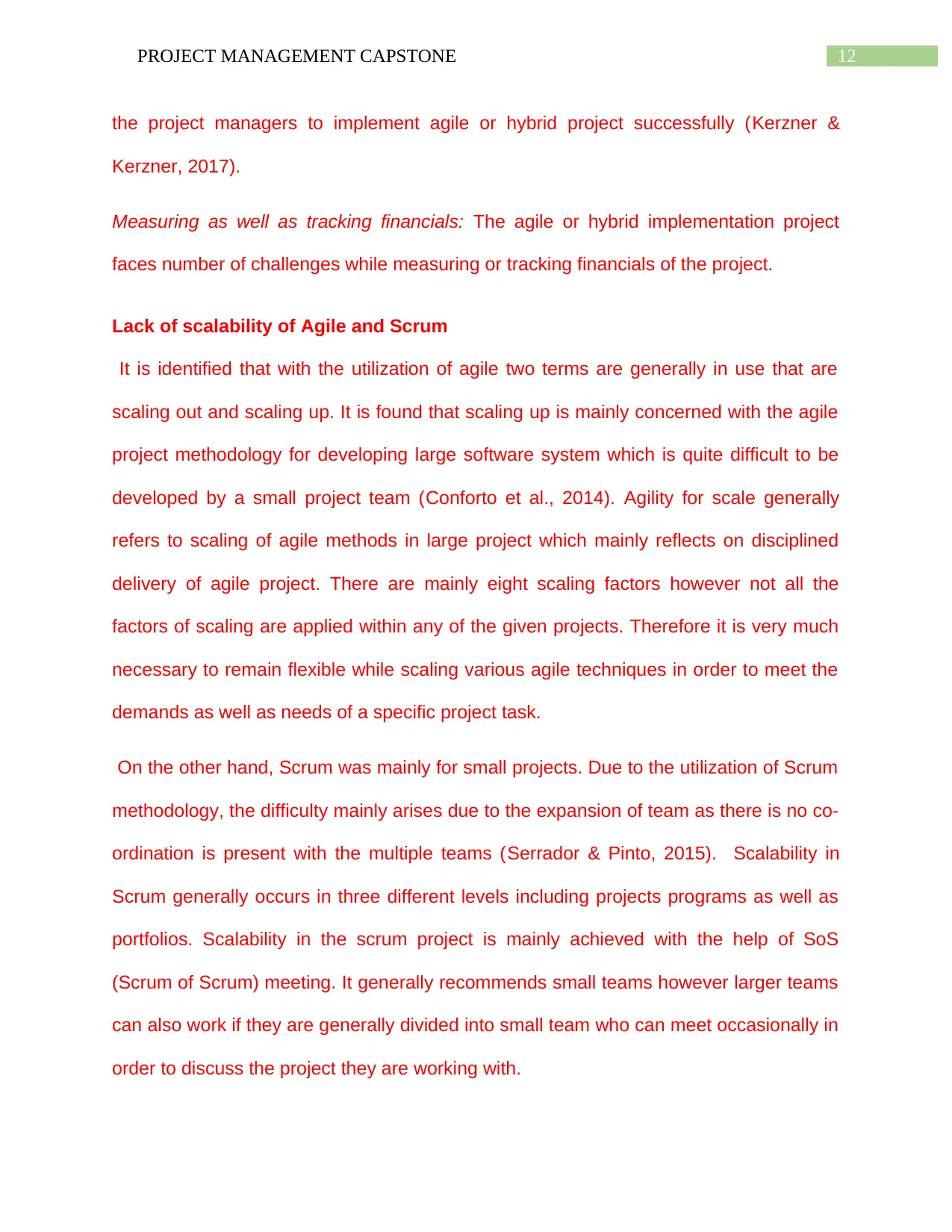
12PROJECT MANAGEMENT CAPSTONE
the project managers to implement agile or hybrid project successfully (Kerzner &
Kerzner, 2017).
Measuring as well as tracking financials: The agile or hybrid implementation project
faces number of challenges while measuring or tracking financials of the project.
Lack of scalability of Agile and Scrum
It is identified that with the utilization of agile two terms are generally in use that are
scaling out and scaling up. It is found that scaling up is mainly concerned with the agile
project methodology for developing large software system which is quite difficult to be
developed by a small project team (Conforto et al., 2014). Agility for scale generally
refers to scaling of agile methods in large project which mainly reflects on disciplined
delivery of agile project. There are mainly eight scaling factors however not all the
factors of scaling are applied within any of the given projects. Therefore it is very much
necessary to remain flexible while scaling various agile techniques in order to meet the
demands as well as needs of a specific project task.
On the other hand, Scrum was mainly for small projects. Due to the utilization of Scrum
methodology, the difficulty mainly arises due to the expansion of team as there is no co-
ordination is present with the multiple teams (Serrador & Pinto, 2015). Scalability in
Scrum generally occurs in three different levels including projects programs as well as
portfolios. Scalability in the scrum project is mainly achieved with the help of SoS
(Scrum of Scrum) meeting. It generally recommends small teams however larger teams
can also work if they are generally divided into small team who can meet occasionally in
order to discuss the project they are working with.
the project managers to implement agile or hybrid project successfully (Kerzner &
Kerzner, 2017).
Measuring as well as tracking financials: The agile or hybrid implementation project
faces number of challenges while measuring or tracking financials of the project.
Lack of scalability of Agile and Scrum
It is identified that with the utilization of agile two terms are generally in use that are
scaling out and scaling up. It is found that scaling up is mainly concerned with the agile
project methodology for developing large software system which is quite difficult to be
developed by a small project team (Conforto et al., 2014). Agility for scale generally
refers to scaling of agile methods in large project which mainly reflects on disciplined
delivery of agile project. There are mainly eight scaling factors however not all the
factors of scaling are applied within any of the given projects. Therefore it is very much
necessary to remain flexible while scaling various agile techniques in order to meet the
demands as well as needs of a specific project task.
On the other hand, Scrum was mainly for small projects. Due to the utilization of Scrum
methodology, the difficulty mainly arises due to the expansion of team as there is no co-
ordination is present with the multiple teams (Serrador & Pinto, 2015). Scalability in
Scrum generally occurs in three different levels including projects programs as well as
portfolios. Scalability in the scrum project is mainly achieved with the help of SoS
(Scrum of Scrum) meeting. It generally recommends small teams however larger teams
can also work if they are generally divided into small team who can meet occasionally in
order to discuss the project they are working with.
Paraphrase This Document
Need a fresh take? Get an instant paraphrase of this document with our AI Paraphraser
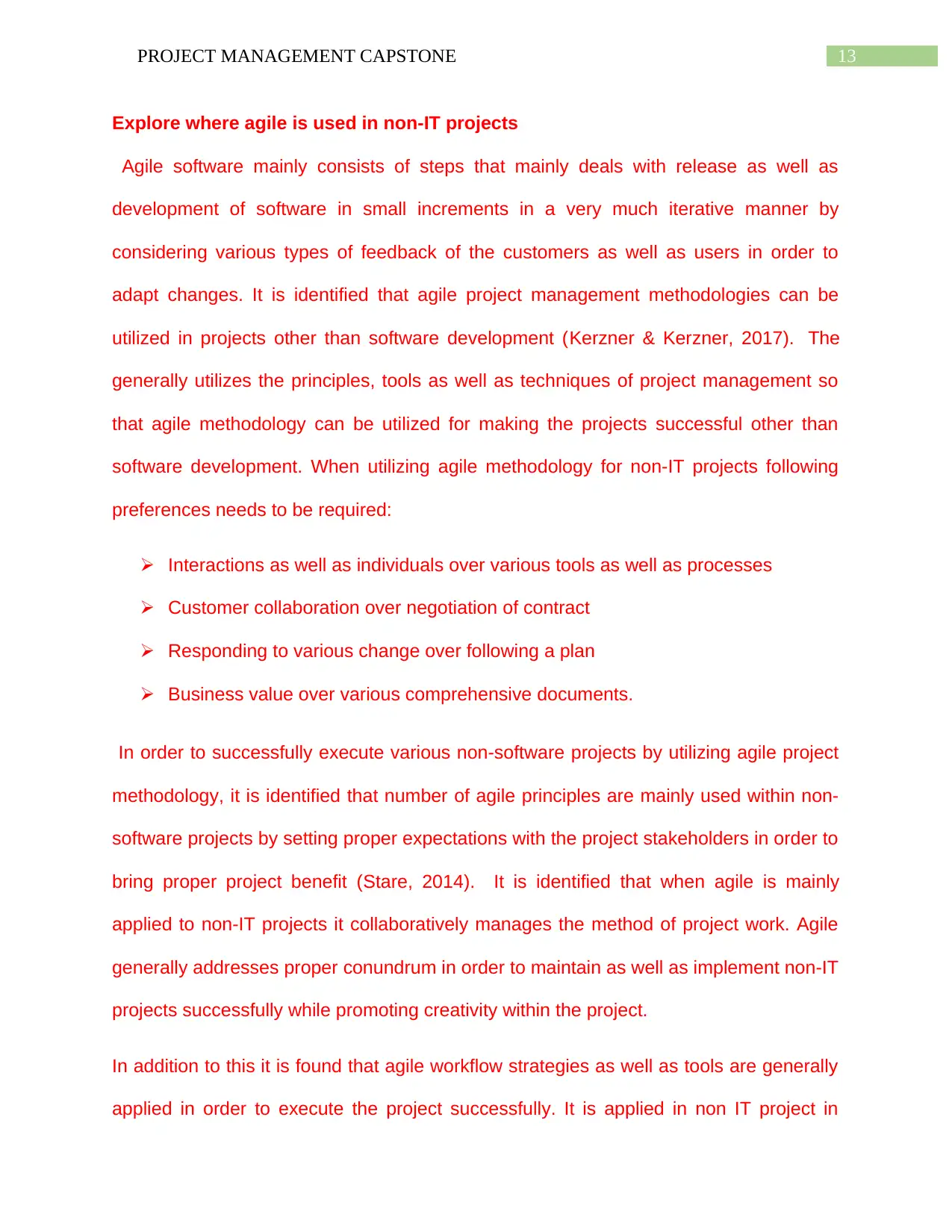
13PROJECT MANAGEMENT CAPSTONE
Explore where agile is used in non-IT projects
Agile software mainly consists of steps that mainly deals with release as well as
development of software in small increments in a very much iterative manner by
considering various types of feedback of the customers as well as users in order to
adapt changes. It is identified that agile project management methodologies can be
utilized in projects other than software development (Kerzner & Kerzner, 2017). The
generally utilizes the principles, tools as well as techniques of project management so
that agile methodology can be utilized for making the projects successful other than
software development. When utilizing agile methodology for non-IT projects following
preferences needs to be required:
Interactions as well as individuals over various tools as well as processes
Customer collaboration over negotiation of contract
Responding to various change over following a plan
Business value over various comprehensive documents.
In order to successfully execute various non-software projects by utilizing agile project
methodology, it is identified that number of agile principles are mainly used within non-
software projects by setting proper expectations with the project stakeholders in order to
bring proper project benefit (Stare, 2014). It is identified that when agile is mainly
applied to non-IT projects it collaboratively manages the method of project work. Agile
generally addresses proper conundrum in order to maintain as well as implement non-IT
projects successfully while promoting creativity within the project.
In addition to this it is found that agile workflow strategies as well as tools are generally
applied in order to execute the project successfully. It is applied in non IT project in
Explore where agile is used in non-IT projects
Agile software mainly consists of steps that mainly deals with release as well as
development of software in small increments in a very much iterative manner by
considering various types of feedback of the customers as well as users in order to
adapt changes. It is identified that agile project management methodologies can be
utilized in projects other than software development (Kerzner & Kerzner, 2017). The
generally utilizes the principles, tools as well as techniques of project management so
that agile methodology can be utilized for making the projects successful other than
software development. When utilizing agile methodology for non-IT projects following
preferences needs to be required:
Interactions as well as individuals over various tools as well as processes
Customer collaboration over negotiation of contract
Responding to various change over following a plan
Business value over various comprehensive documents.
In order to successfully execute various non-software projects by utilizing agile project
methodology, it is identified that number of agile principles are mainly used within non-
software projects by setting proper expectations with the project stakeholders in order to
bring proper project benefit (Stare, 2014). It is identified that when agile is mainly
applied to non-IT projects it collaboratively manages the method of project work. Agile
generally addresses proper conundrum in order to maintain as well as implement non-IT
projects successfully while promoting creativity within the project.
In addition to this it is found that agile workflow strategies as well as tools are generally
applied in order to execute the project successfully. It is applied in non IT project in
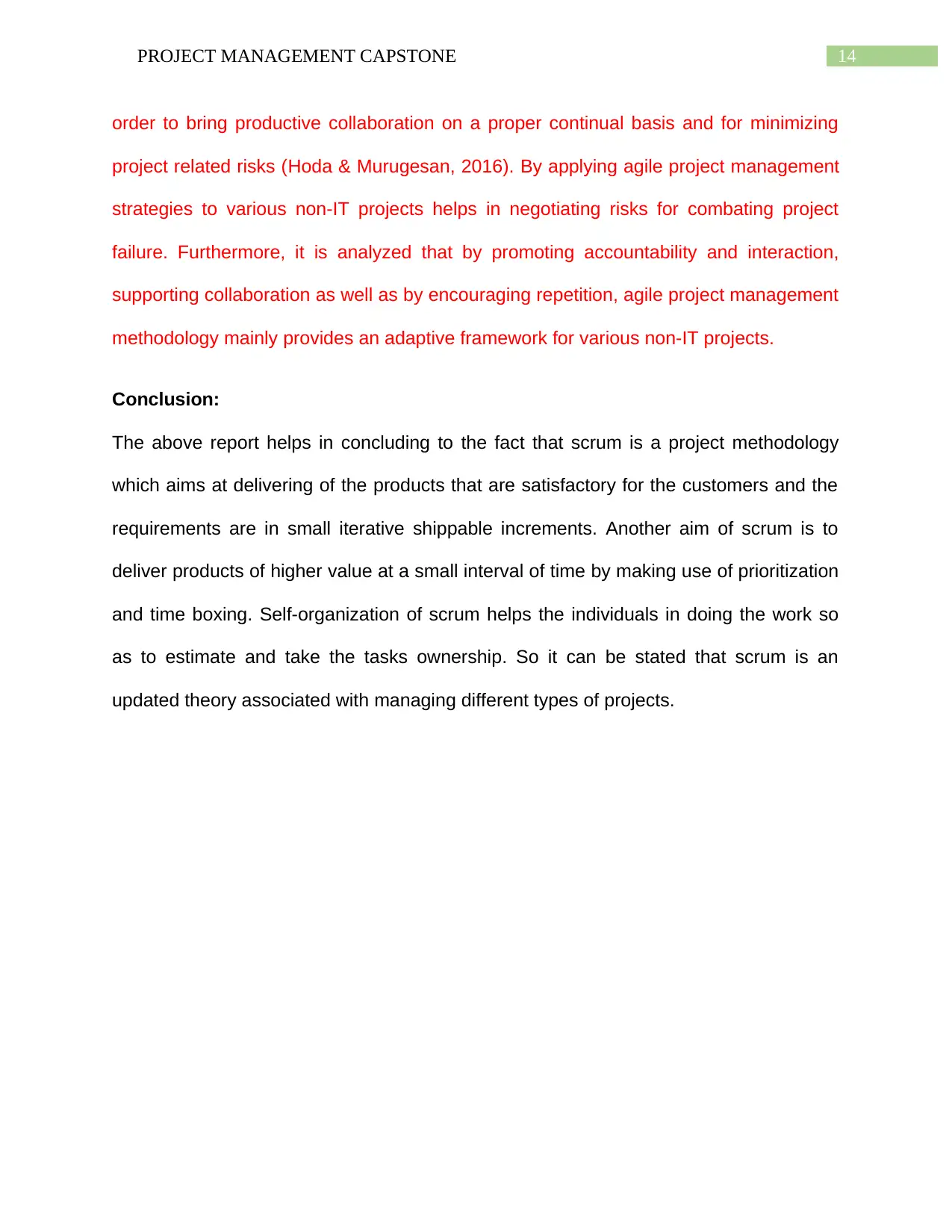
14PROJECT MANAGEMENT CAPSTONE
order to bring productive collaboration on a proper continual basis and for minimizing
project related risks (Hoda & Murugesan, 2016). By applying agile project management
strategies to various non-IT projects helps in negotiating risks for combating project
failure. Furthermore, it is analyzed that by promoting accountability and interaction,
supporting collaboration as well as by encouraging repetition, agile project management
methodology mainly provides an adaptive framework for various non-IT projects.
Conclusion:
The above report helps in concluding to the fact that scrum is a project methodology
which aims at delivering of the products that are satisfactory for the customers and the
requirements are in small iterative shippable increments. Another aim of scrum is to
deliver products of higher value at a small interval of time by making use of prioritization
and time boxing. Self-organization of scrum helps the individuals in doing the work so
as to estimate and take the tasks ownership. So it can be stated that scrum is an
updated theory associated with managing different types of projects.
order to bring productive collaboration on a proper continual basis and for minimizing
project related risks (Hoda & Murugesan, 2016). By applying agile project management
strategies to various non-IT projects helps in negotiating risks for combating project
failure. Furthermore, it is analyzed that by promoting accountability and interaction,
supporting collaboration as well as by encouraging repetition, agile project management
methodology mainly provides an adaptive framework for various non-IT projects.
Conclusion:
The above report helps in concluding to the fact that scrum is a project methodology
which aims at delivering of the products that are satisfactory for the customers and the
requirements are in small iterative shippable increments. Another aim of scrum is to
deliver products of higher value at a small interval of time by making use of prioritization
and time boxing. Self-organization of scrum helps the individuals in doing the work so
as to estimate and take the tasks ownership. So it can be stated that scrum is an
updated theory associated with managing different types of projects.
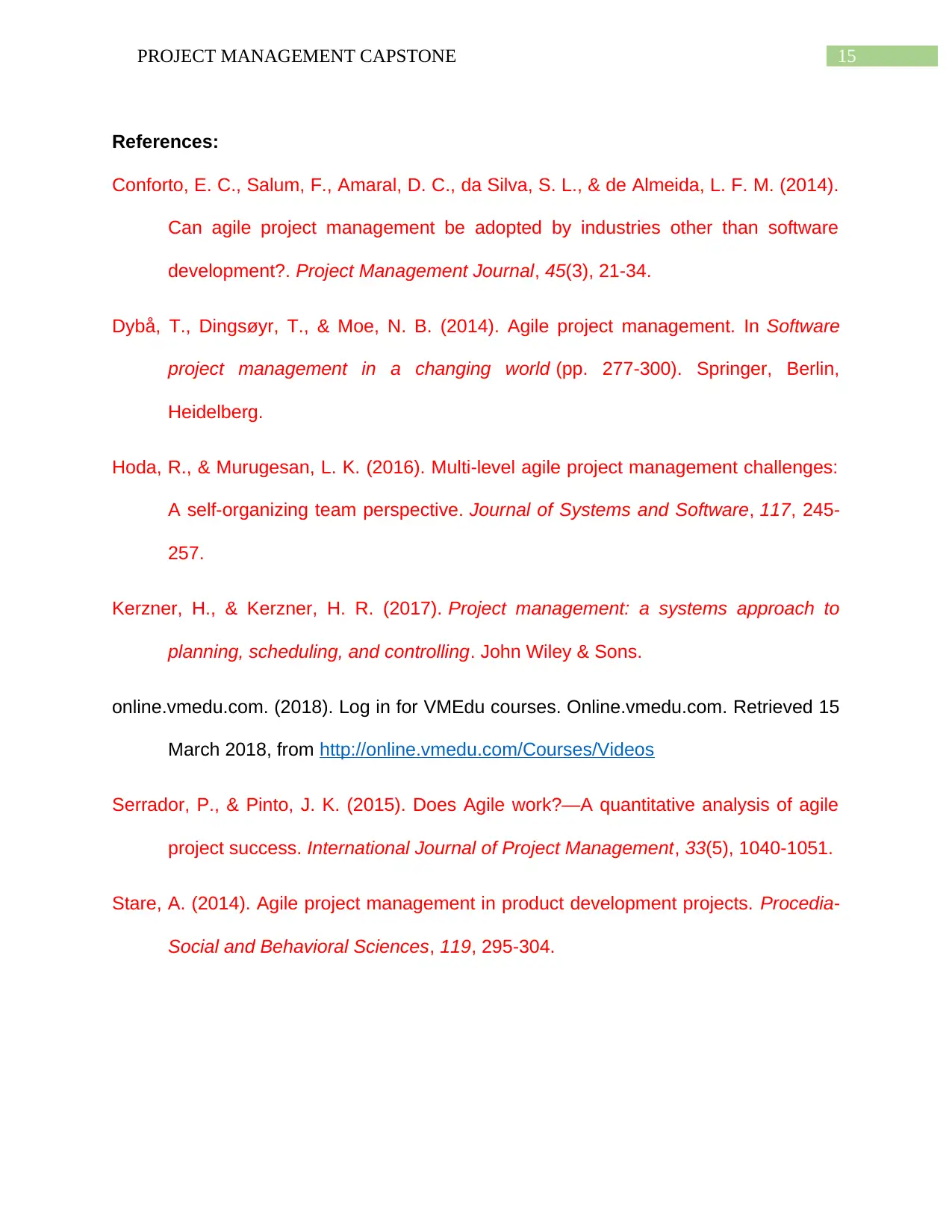
15PROJECT MANAGEMENT CAPSTONE
References:
Conforto, E. C., Salum, F., Amaral, D. C., da Silva, S. L., & de Almeida, L. F. M. (2014).
Can agile project management be adopted by industries other than software
development?. Project Management Journal, 45(3), 21-34.
Dybå, T., Dingsøyr, T., & Moe, N. B. (2014). Agile project management. In Software
project management in a changing world (pp. 277-300). Springer, Berlin,
Heidelberg.
Hoda, R., & Murugesan, L. K. (2016). Multi-level agile project management challenges:
A self-organizing team perspective. Journal of Systems and Software, 117, 245-
257.
Kerzner, H., & Kerzner, H. R. (2017). Project management: a systems approach to
planning, scheduling, and controlling. John Wiley & Sons.
online.vmedu.com. (2018). Log in for VMEdu courses. Online.vmedu.com. Retrieved 15
March 2018, from http://online.vmedu.com/Courses/Videos
Serrador, P., & Pinto, J. K. (2015). Does Agile work?—A quantitative analysis of agile
project success. International Journal of Project Management, 33(5), 1040-1051.
Stare, A. (2014). Agile project management in product development projects. Procedia-
Social and Behavioral Sciences, 119, 295-304.
References:
Conforto, E. C., Salum, F., Amaral, D. C., da Silva, S. L., & de Almeida, L. F. M. (2014).
Can agile project management be adopted by industries other than software
development?. Project Management Journal, 45(3), 21-34.
Dybå, T., Dingsøyr, T., & Moe, N. B. (2014). Agile project management. In Software
project management in a changing world (pp. 277-300). Springer, Berlin,
Heidelberg.
Hoda, R., & Murugesan, L. K. (2016). Multi-level agile project management challenges:
A self-organizing team perspective. Journal of Systems and Software, 117, 245-
257.
Kerzner, H., & Kerzner, H. R. (2017). Project management: a systems approach to
planning, scheduling, and controlling. John Wiley & Sons.
online.vmedu.com. (2018). Log in for VMEdu courses. Online.vmedu.com. Retrieved 15
March 2018, from http://online.vmedu.com/Courses/Videos
Serrador, P., & Pinto, J. K. (2015). Does Agile work?—A quantitative analysis of agile
project success. International Journal of Project Management, 33(5), 1040-1051.
Stare, A. (2014). Agile project management in product development projects. Procedia-
Social and Behavioral Sciences, 119, 295-304.
1 out of 16
Related Documents
Your All-in-One AI-Powered Toolkit for Academic Success.
+13062052269
info@desklib.com
Available 24*7 on WhatsApp / Email
![[object Object]](/_next/static/media/star-bottom.7253800d.svg)
Unlock your academic potential
© 2024 | Zucol Services PVT LTD | All rights reserved.





